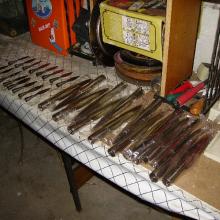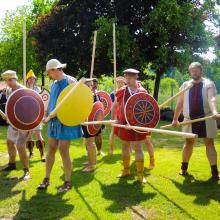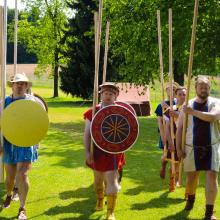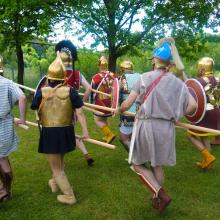Since we started to become interested in ancient Greece, we were fascinated by Alexander III of Macedon and his remarkable eastern conquest. A basic requirement for him to earn his name "the Great" was without a doubt the Macedonian army reformed by his father. A central part of the army reforms of Philipp II was the new Macedonian phalanx equipped with the sarisa, which dominated the hellenistic battlefields for the following two centuries. Even after Aemilius Paullus was able to break its dominance through his victory at Pydna, seeing the Macedonian Phalanx in action left a lasting impression on his memory, as several ancient authors tell us.
"and when he saw not only the other Macedonians, but those who constituted the phalanx, [..] with their pikes inclined in one direction receiving the attack of the Romans, admiring the firmness of the serried ranks, and the bristling rampart of outstretched pikes, he was smitten at once with astonishment and terror, as if he had never seen so fearful a spectacle" - Liv. 44 40, siehe auch Plb. 29.17
Obwohl sie in zahllosen modernen Abbildungen, Filmen, Videospielen, oder Büchern vorkommt, und in vielen antiken Texten erwähnt und vermeintlich erklärt wird, ist bis heute unklar, wie diese furchteinflössende Formation prinzipiell funktioniert hat.
Although it is depicted in countless modern artworks, movies, video games, or books, and it is described and explained by many ancient authors, to this day it remains unknown how this terrifying formation actually worked.
Reconstruction Attempts
A few attempts were made at reconstructing an authentic single sarisa, some of them were conducted by us ourselves. Reconstruction attempts of the Macedonian phalanx formation are even rarer. For one, there is an attempt by Prof. Markle, which can be watched in the following video:
A similar experiment was conducted by Prof. Victor Parker with students at the University of Canterbury.
The Hetairoi Phalanx Experiment
The reconstruction attempts mentioned above both only deal with handling the sarisa in a tight formation, as can be seen in the video of Prof. Markle's attempt. however, the weapons in both attempts are not authentic reconstructions, but are just modelled after the ancient sarisa to convey the approximate feeling of handling the weapon. For example the sauroter is missing, which however essentially influences the handling of the sarisa. To this date, there is no attempt to reconstruct the Macedonian phalanx in authentic equipment, e.g. including shields, swords, greaves, helmets, and body armour of a soldier. This is why last year we decided to manufacture the biggest collection of authentic Macedonian weaponry to date, so we can conduct our own experiments on the Macedonian phalanx.
Over the winter break we started constructing peltai and sarisas for our members, so that we have 16 sarisas at disposal for our reconstruction attempt. A few weeks ago on our spring camp we could already train the formation with our group for the first time. In our previous reconstruction attempts of the sarisa, we didn't find it to be very easy to handle, which is why this time we just used wooden shafts for purposes of exercise. This simplification allows us to get used to the formation without the overhead of having to control the huge lance simultaneously.
In our exercise we had nine soldiers at our disposal. We started with Prof. Markle's reconstruction and tried to get a feeling for the amount of space the formation requires, for movement in the formation, and how to switch between marching and battle configurations. During our two training days, we found it challenging to maintain the correct spacing between the individual soldiers of the formation, so that our formation always slowly became more and more chaotic. the main conclusion we took from the weekend is that it takes great discipline to maintain even a formation of 3x3 soldiers - let alone a whole syntagma of 256 men.
On our following meetings, we will continue this experiment, the next time in August at the Freilichmuseum Heuneburg. Until then we will have completed the reconstruction of all peltai and sarisas, so we can conduct the exercises with full weaponry. This will surely enable us to draw better conclusions.






